Program Management Report: Projects, Personal Improvement, and Tools
VerifiedAdded on 2022/12/30
|8
|2108
|32
Report
AI Summary
This report provides an overview of program management, discussing its purpose within a company and its benefits, such as aligning projects with strategic goals, managing interdependencies, and optimizing resource allocation. It then explores personal improvement projects, emphasizing the importance of communication, strategic alignment, trust, and the use of tools like minimum viable product and productivity analysis. The report also highlights essential project management practices including team member accountability, feedback, and setting realistic expectations. Finally, it details tools such as risk registers, prioritization matrices, and capacity planning for effective project execution and resource management. The report underscores the significance of these elements in achieving project success and organizational synergy.
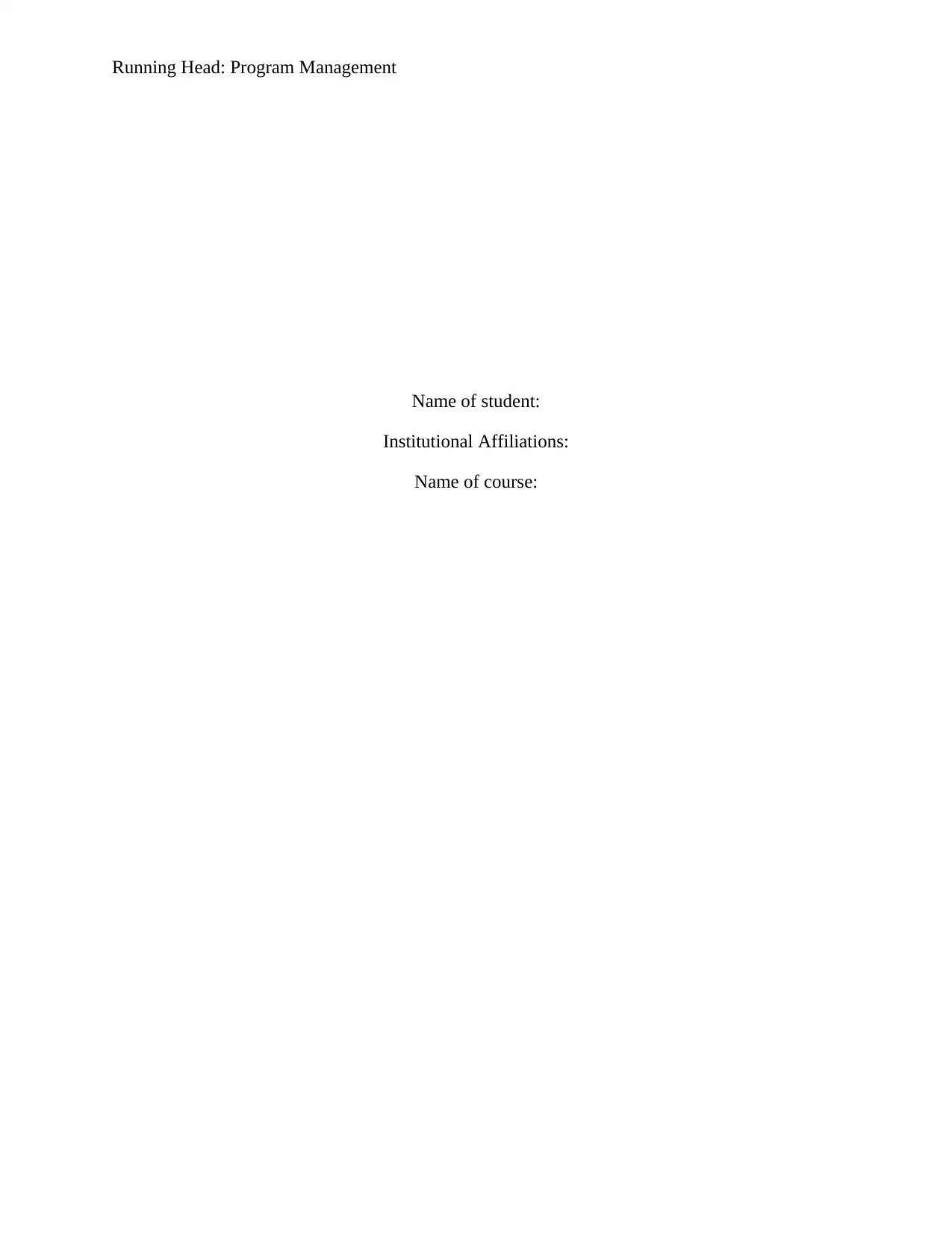
Running Head: Program Management
Name of student:
Institutional Affiliations:
Name of course:
Name of student:
Institutional Affiliations:
Name of course:
Paraphrase This Document
Need a fresh take? Get an instant paraphrase of this document with our AI Paraphraser
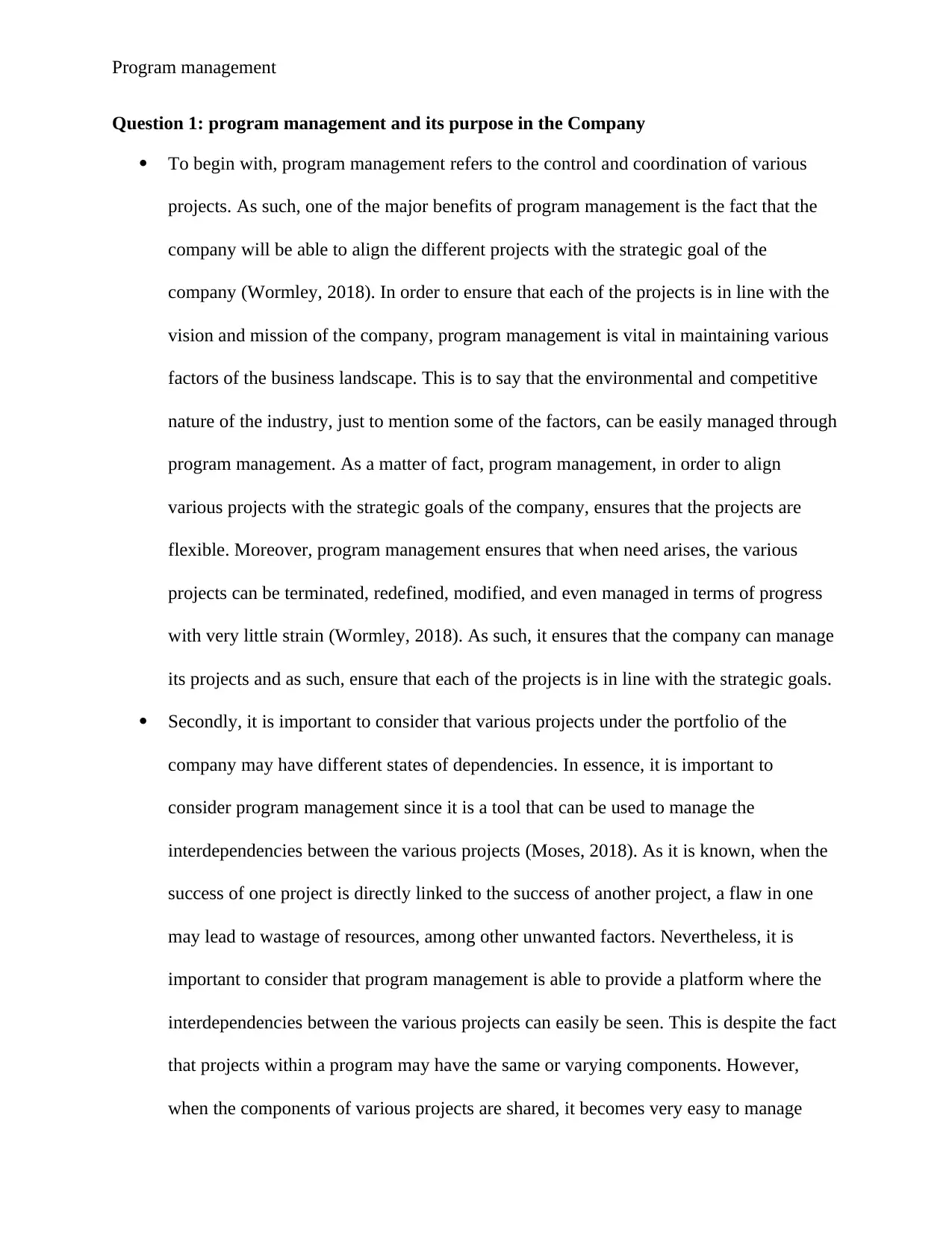
Program management
Question 1: program management and its purpose in the Company
To begin with, program management refers to the control and coordination of various
projects. As such, one of the major benefits of program management is the fact that the
company will be able to align the different projects with the strategic goal of the
company (Wormley, 2018). In order to ensure that each of the projects is in line with the
vision and mission of the company, program management is vital in maintaining various
factors of the business landscape. This is to say that the environmental and competitive
nature of the industry, just to mention some of the factors, can be easily managed through
program management. As a matter of fact, program management, in order to align
various projects with the strategic goals of the company, ensures that the projects are
flexible. Moreover, program management ensures that when need arises, the various
projects can be terminated, redefined, modified, and even managed in terms of progress
with very little strain (Wormley, 2018). As such, it ensures that the company can manage
its projects and as such, ensure that each of the projects is in line with the strategic goals.
Secondly, it is important to consider that various projects under the portfolio of the
company may have different states of dependencies. In essence, it is important to
consider program management since it is a tool that can be used to manage the
interdependencies between the various projects (Moses, 2018). As it is known, when the
success of one project is directly linked to the success of another project, a flaw in one
may lead to wastage of resources, among other unwanted factors. Nevertheless, it is
important to consider that program management is able to provide a platform where the
interdependencies between the various projects can easily be seen. This is despite the fact
that projects within a program may have the same or varying components. However,
when the components of various projects are shared, it becomes very easy to manage
Question 1: program management and its purpose in the Company
To begin with, program management refers to the control and coordination of various
projects. As such, one of the major benefits of program management is the fact that the
company will be able to align the different projects with the strategic goal of the
company (Wormley, 2018). In order to ensure that each of the projects is in line with the
vision and mission of the company, program management is vital in maintaining various
factors of the business landscape. This is to say that the environmental and competitive
nature of the industry, just to mention some of the factors, can be easily managed through
program management. As a matter of fact, program management, in order to align
various projects with the strategic goals of the company, ensures that the projects are
flexible. Moreover, program management ensures that when need arises, the various
projects can be terminated, redefined, modified, and even managed in terms of progress
with very little strain (Wormley, 2018). As such, it ensures that the company can manage
its projects and as such, ensure that each of the projects is in line with the strategic goals.
Secondly, it is important to consider that various projects under the portfolio of the
company may have different states of dependencies. In essence, it is important to
consider program management since it is a tool that can be used to manage the
interdependencies between the various projects (Moses, 2018). As it is known, when the
success of one project is directly linked to the success of another project, a flaw in one
may lead to wastage of resources, among other unwanted factors. Nevertheless, it is
important to consider that program management is able to provide a platform where the
interdependencies between the various projects can easily be seen. This is despite the fact
that projects within a program may have the same or varying components. However,
when the components of various projects are shared, it becomes very easy to manage
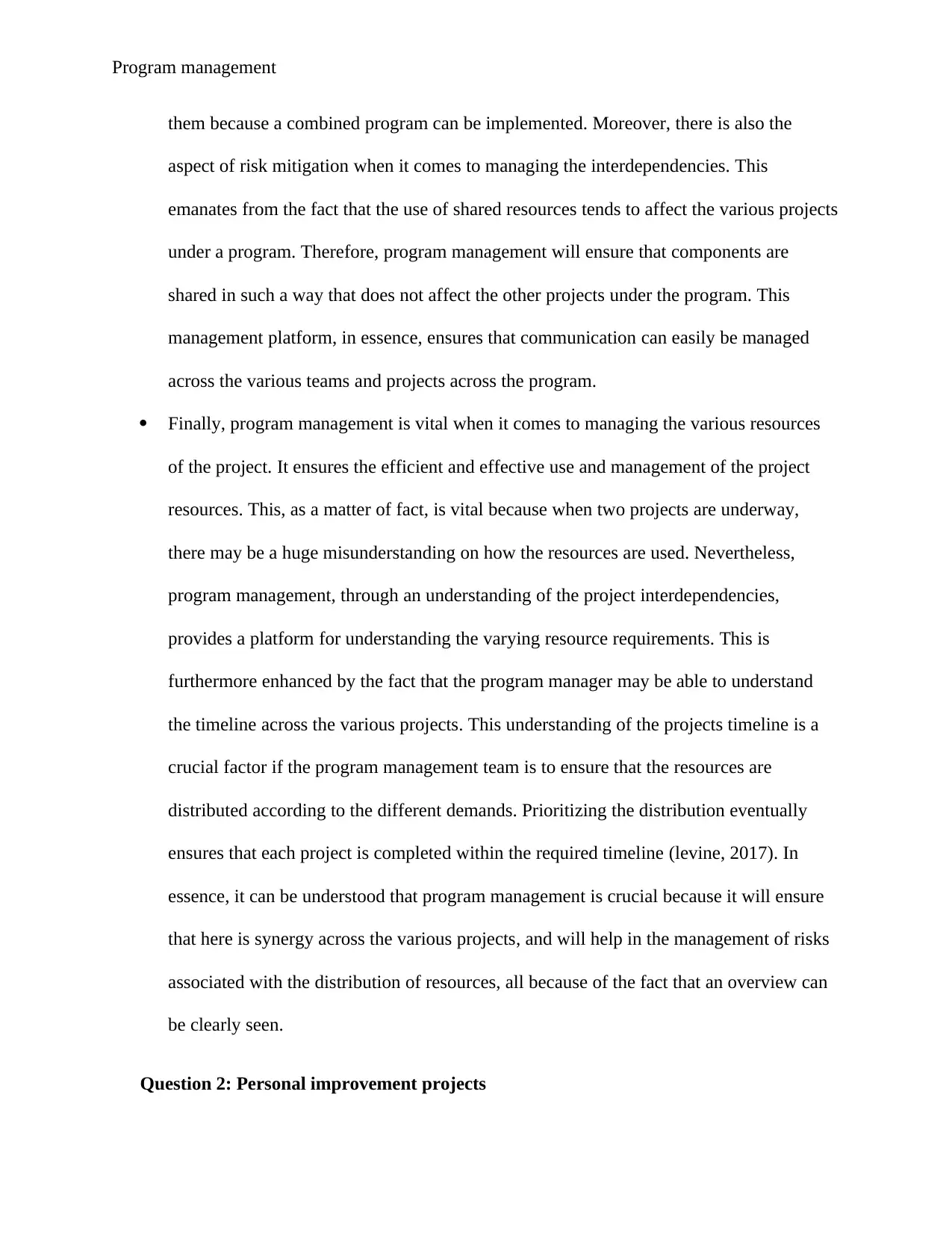
Program management
them because a combined program can be implemented. Moreover, there is also the
aspect of risk mitigation when it comes to managing the interdependencies. This
emanates from the fact that the use of shared resources tends to affect the various projects
under a program. Therefore, program management will ensure that components are
shared in such a way that does not affect the other projects under the program. This
management platform, in essence, ensures that communication can easily be managed
across the various teams and projects across the program.
Finally, program management is vital when it comes to managing the various resources
of the project. It ensures the efficient and effective use and management of the project
resources. This, as a matter of fact, is vital because when two projects are underway,
there may be a huge misunderstanding on how the resources are used. Nevertheless,
program management, through an understanding of the project interdependencies,
provides a platform for understanding the varying resource requirements. This is
furthermore enhanced by the fact that the program manager may be able to understand
the timeline across the various projects. This understanding of the projects timeline is a
crucial factor if the program management team is to ensure that the resources are
distributed according to the different demands. Prioritizing the distribution eventually
ensures that each project is completed within the required timeline (levine, 2017). In
essence, it can be understood that program management is crucial because it will ensure
that here is synergy across the various projects, and will help in the management of risks
associated with the distribution of resources, all because of the fact that an overview can
be clearly seen.
Question 2: Personal improvement projects
them because a combined program can be implemented. Moreover, there is also the
aspect of risk mitigation when it comes to managing the interdependencies. This
emanates from the fact that the use of shared resources tends to affect the various projects
under a program. Therefore, program management will ensure that components are
shared in such a way that does not affect the other projects under the program. This
management platform, in essence, ensures that communication can easily be managed
across the various teams and projects across the program.
Finally, program management is vital when it comes to managing the various resources
of the project. It ensures the efficient and effective use and management of the project
resources. This, as a matter of fact, is vital because when two projects are underway,
there may be a huge misunderstanding on how the resources are used. Nevertheless,
program management, through an understanding of the project interdependencies,
provides a platform for understanding the varying resource requirements. This is
furthermore enhanced by the fact that the program manager may be able to understand
the timeline across the various projects. This understanding of the projects timeline is a
crucial factor if the program management team is to ensure that the resources are
distributed according to the different demands. Prioritizing the distribution eventually
ensures that each project is completed within the required timeline (levine, 2017). In
essence, it can be understood that program management is crucial because it will ensure
that here is synergy across the various projects, and will help in the management of risks
associated with the distribution of resources, all because of the fact that an overview can
be clearly seen.
Question 2: Personal improvement projects
⊘ This is a preview!⊘
Do you want full access?
Subscribe today to unlock all pages.

Trusted by 1+ million students worldwide
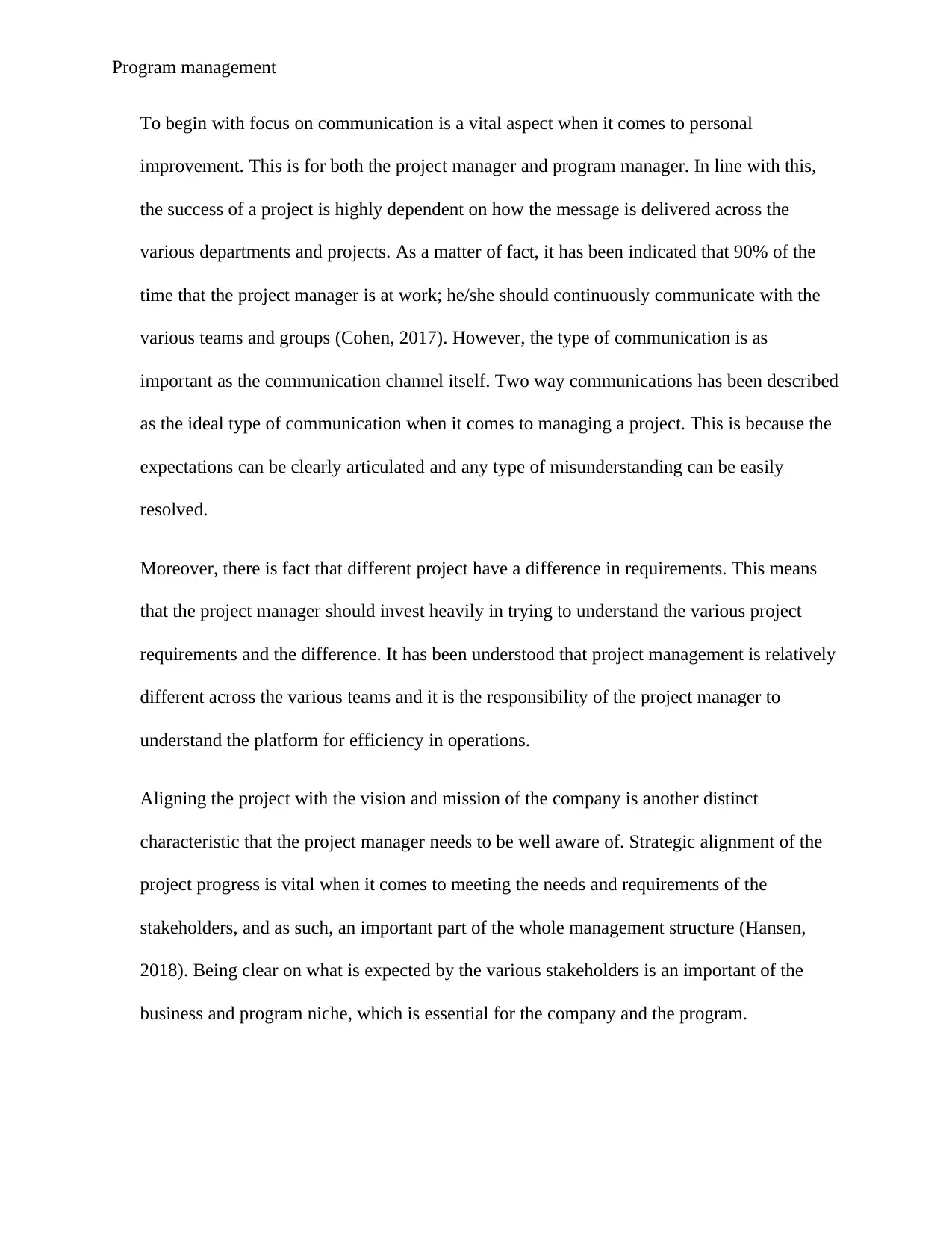
Program management
To begin with focus on communication is a vital aspect when it comes to personal
improvement. This is for both the project manager and program manager. In line with this,
the success of a project is highly dependent on how the message is delivered across the
various departments and projects. As a matter of fact, it has been indicated that 90% of the
time that the project manager is at work; he/she should continuously communicate with the
various teams and groups (Cohen, 2017). However, the type of communication is as
important as the communication channel itself. Two way communications has been described
as the ideal type of communication when it comes to managing a project. This is because the
expectations can be clearly articulated and any type of misunderstanding can be easily
resolved.
Moreover, there is fact that different project have a difference in requirements. This means
that the project manager should invest heavily in trying to understand the various project
requirements and the difference. It has been understood that project management is relatively
different across the various teams and it is the responsibility of the project manager to
understand the platform for efficiency in operations.
Aligning the project with the vision and mission of the company is another distinct
characteristic that the project manager needs to be well aware of. Strategic alignment of the
project progress is vital when it comes to meeting the needs and requirements of the
stakeholders, and as such, an important part of the whole management structure (Hansen,
2018). Being clear on what is expected by the various stakeholders is an important of the
business and program niche, which is essential for the company and the program.
To begin with focus on communication is a vital aspect when it comes to personal
improvement. This is for both the project manager and program manager. In line with this,
the success of a project is highly dependent on how the message is delivered across the
various departments and projects. As a matter of fact, it has been indicated that 90% of the
time that the project manager is at work; he/she should continuously communicate with the
various teams and groups (Cohen, 2017). However, the type of communication is as
important as the communication channel itself. Two way communications has been described
as the ideal type of communication when it comes to managing a project. This is because the
expectations can be clearly articulated and any type of misunderstanding can be easily
resolved.
Moreover, there is fact that different project have a difference in requirements. This means
that the project manager should invest heavily in trying to understand the various project
requirements and the difference. It has been understood that project management is relatively
different across the various teams and it is the responsibility of the project manager to
understand the platform for efficiency in operations.
Aligning the project with the vision and mission of the company is another distinct
characteristic that the project manager needs to be well aware of. Strategic alignment of the
project progress is vital when it comes to meeting the needs and requirements of the
stakeholders, and as such, an important part of the whole management structure (Hansen,
2018). Being clear on what is expected by the various stakeholders is an important of the
business and program niche, which is essential for the company and the program.
Paraphrase This Document
Need a fresh take? Get an instant paraphrase of this document with our AI Paraphraser
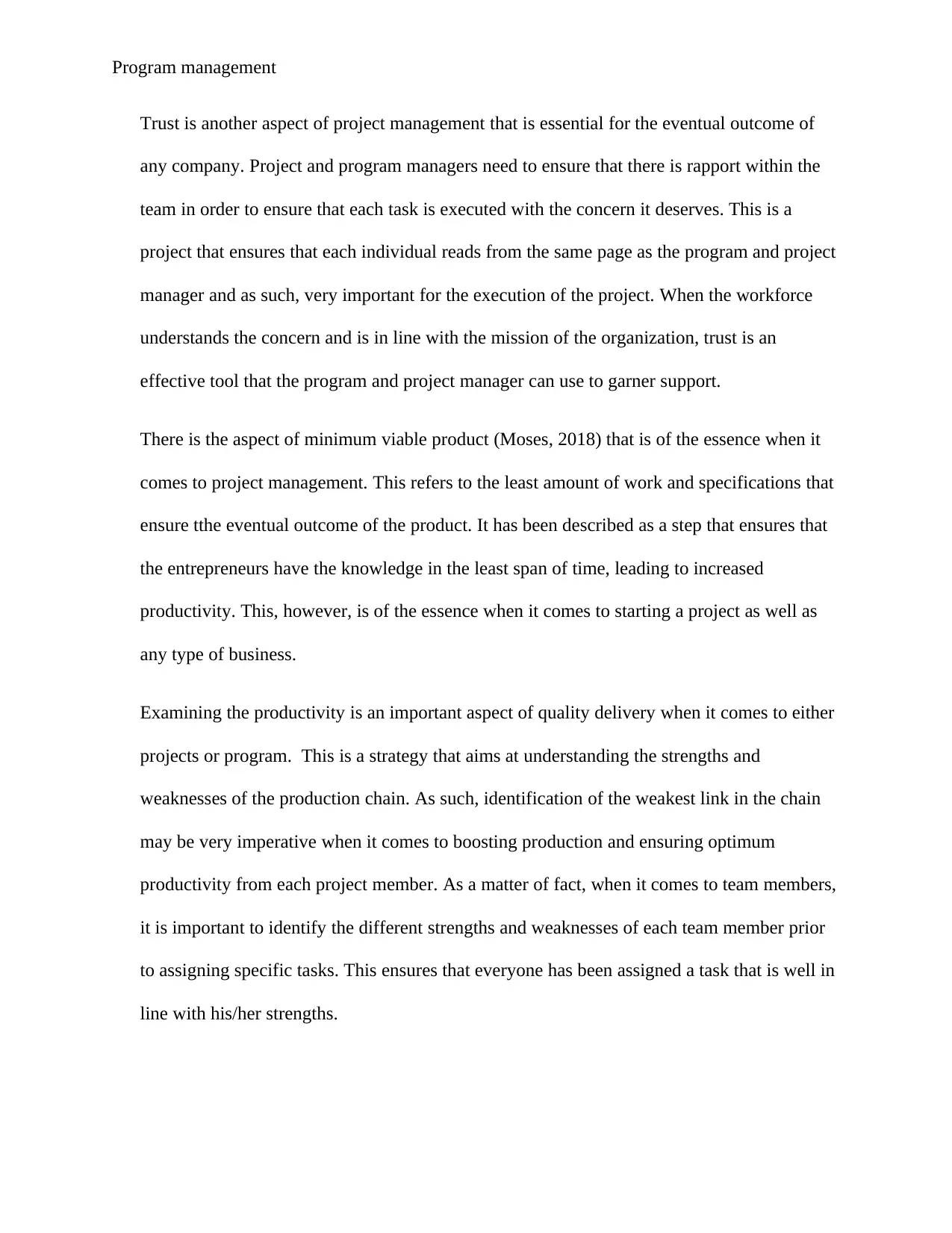
Program management
Trust is another aspect of project management that is essential for the eventual outcome of
any company. Project and program managers need to ensure that there is rapport within the
team in order to ensure that each task is executed with the concern it deserves. This is a
project that ensures that each individual reads from the same page as the program and project
manager and as such, very important for the execution of the project. When the workforce
understands the concern and is in line with the mission of the organization, trust is an
effective tool that the program and project manager can use to garner support.
There is the aspect of minimum viable product (Moses, 2018) that is of the essence when it
comes to project management. This refers to the least amount of work and specifications that
ensure tthe eventual outcome of the product. It has been described as a step that ensures that
the entrepreneurs have the knowledge in the least span of time, leading to increased
productivity. This, however, is of the essence when it comes to starting a project as well as
any type of business.
Examining the productivity is an important aspect of quality delivery when it comes to either
projects or program. This is a strategy that aims at understanding the strengths and
weaknesses of the production chain. As such, identification of the weakest link in the chain
may be very imperative when it comes to boosting production and ensuring optimum
productivity from each project member. As a matter of fact, when it comes to team members,
it is important to identify the different strengths and weaknesses of each team member prior
to assigning specific tasks. This ensures that everyone has been assigned a task that is well in
line with his/her strengths.
Trust is another aspect of project management that is essential for the eventual outcome of
any company. Project and program managers need to ensure that there is rapport within the
team in order to ensure that each task is executed with the concern it deserves. This is a
project that ensures that each individual reads from the same page as the program and project
manager and as such, very important for the execution of the project. When the workforce
understands the concern and is in line with the mission of the organization, trust is an
effective tool that the program and project manager can use to garner support.
There is the aspect of minimum viable product (Moses, 2018) that is of the essence when it
comes to project management. This refers to the least amount of work and specifications that
ensure tthe eventual outcome of the product. It has been described as a step that ensures that
the entrepreneurs have the knowledge in the least span of time, leading to increased
productivity. This, however, is of the essence when it comes to starting a project as well as
any type of business.
Examining the productivity is an important aspect of quality delivery when it comes to either
projects or program. This is a strategy that aims at understanding the strengths and
weaknesses of the production chain. As such, identification of the weakest link in the chain
may be very imperative when it comes to boosting production and ensuring optimum
productivity from each project member. As a matter of fact, when it comes to team members,
it is important to identify the different strengths and weaknesses of each team member prior
to assigning specific tasks. This ensures that everyone has been assigned a task that is well in
line with his/her strengths.
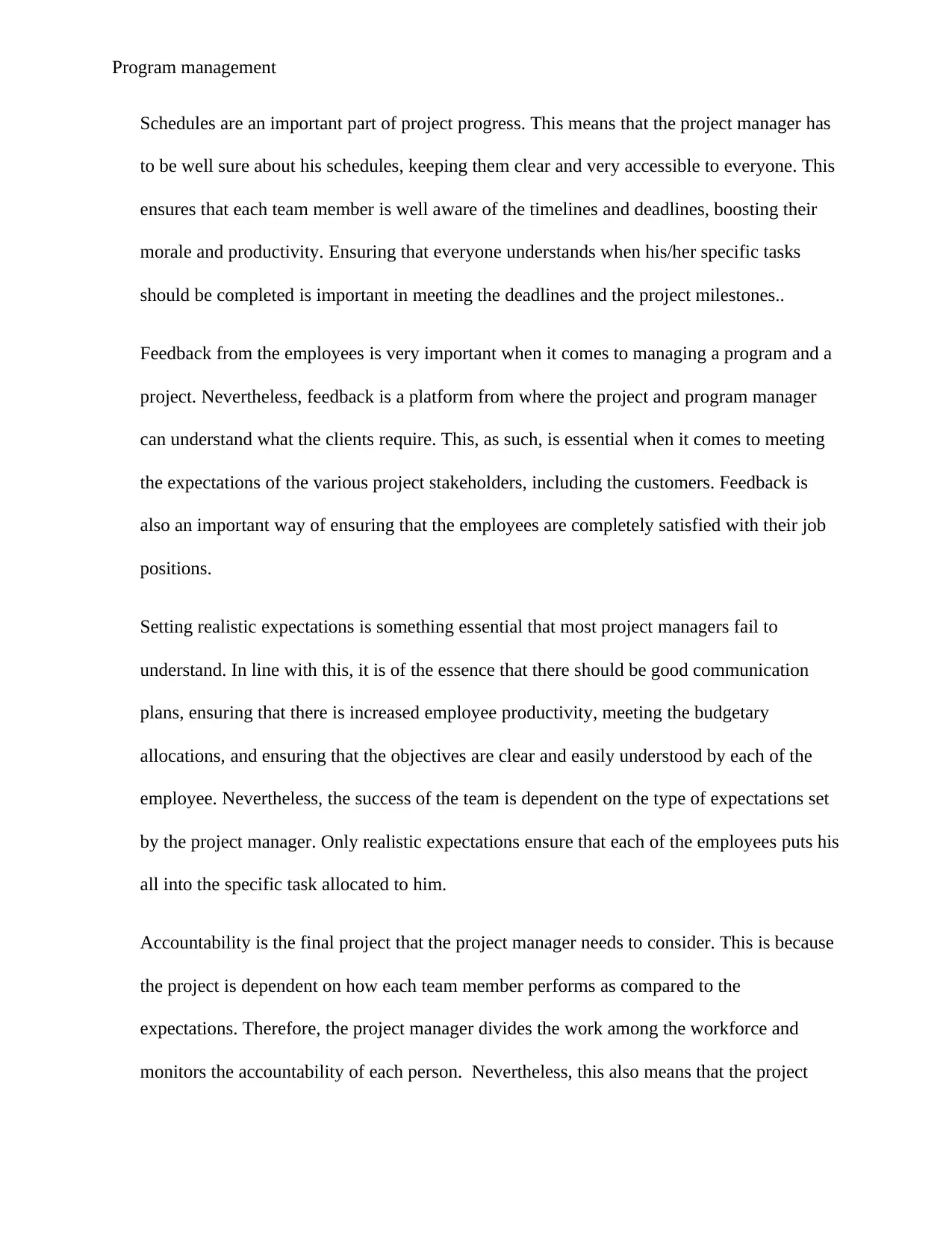
Program management
Schedules are an important part of project progress. This means that the project manager has
to be well sure about his schedules, keeping them clear and very accessible to everyone. This
ensures that each team member is well aware of the timelines and deadlines, boosting their
morale and productivity. Ensuring that everyone understands when his/her specific tasks
should be completed is important in meeting the deadlines and the project milestones..
Feedback from the employees is very important when it comes to managing a program and a
project. Nevertheless, feedback is a platform from where the project and program manager
can understand what the clients require. This, as such, is essential when it comes to meeting
the expectations of the various project stakeholders, including the customers. Feedback is
also an important way of ensuring that the employees are completely satisfied with their job
positions.
Setting realistic expectations is something essential that most project managers fail to
understand. In line with this, it is of the essence that there should be good communication
plans, ensuring that there is increased employee productivity, meeting the budgetary
allocations, and ensuring that the objectives are clear and easily understood by each of the
employee. Nevertheless, the success of the team is dependent on the type of expectations set
by the project manager. Only realistic expectations ensure that each of the employees puts his
all into the specific task allocated to him.
Accountability is the final project that the project manager needs to consider. This is because
the project is dependent on how each team member performs as compared to the
expectations. Therefore, the project manager divides the work among the workforce and
monitors the accountability of each person. Nevertheless, this also means that the project
Schedules are an important part of project progress. This means that the project manager has
to be well sure about his schedules, keeping them clear and very accessible to everyone. This
ensures that each team member is well aware of the timelines and deadlines, boosting their
morale and productivity. Ensuring that everyone understands when his/her specific tasks
should be completed is important in meeting the deadlines and the project milestones..
Feedback from the employees is very important when it comes to managing a program and a
project. Nevertheless, feedback is a platform from where the project and program manager
can understand what the clients require. This, as such, is essential when it comes to meeting
the expectations of the various project stakeholders, including the customers. Feedback is
also an important way of ensuring that the employees are completely satisfied with their job
positions.
Setting realistic expectations is something essential that most project managers fail to
understand. In line with this, it is of the essence that there should be good communication
plans, ensuring that there is increased employee productivity, meeting the budgetary
allocations, and ensuring that the objectives are clear and easily understood by each of the
employee. Nevertheless, the success of the team is dependent on the type of expectations set
by the project manager. Only realistic expectations ensure that each of the employees puts his
all into the specific task allocated to him.
Accountability is the final project that the project manager needs to consider. This is because
the project is dependent on how each team member performs as compared to the
expectations. Therefore, the project manager divides the work among the workforce and
monitors the accountability of each person. Nevertheless, this also means that the project
⊘ This is a preview!⊘
Do you want full access?
Subscribe today to unlock all pages.

Trusted by 1+ million students worldwide
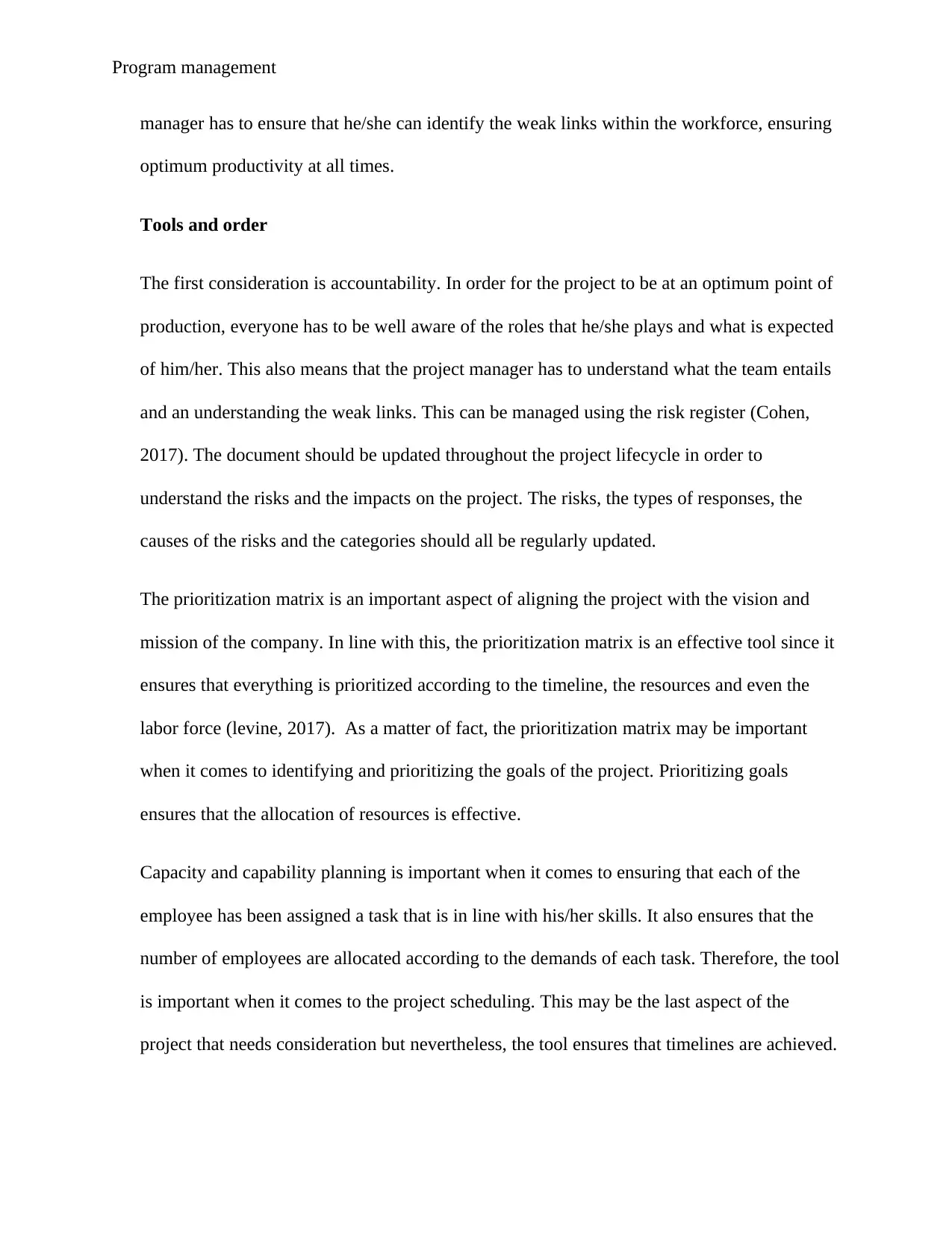
Program management
manager has to ensure that he/she can identify the weak links within the workforce, ensuring
optimum productivity at all times.
Tools and order
The first consideration is accountability. In order for the project to be at an optimum point of
production, everyone has to be well aware of the roles that he/she plays and what is expected
of him/her. This also means that the project manager has to understand what the team entails
and an understanding the weak links. This can be managed using the risk register (Cohen,
2017). The document should be updated throughout the project lifecycle in order to
understand the risks and the impacts on the project. The risks, the types of responses, the
causes of the risks and the categories should all be regularly updated.
The prioritization matrix is an important aspect of aligning the project with the vision and
mission of the company. In line with this, the prioritization matrix is an effective tool since it
ensures that everything is prioritized according to the timeline, the resources and even the
labor force (levine, 2017). As a matter of fact, the prioritization matrix may be important
when it comes to identifying and prioritizing the goals of the project. Prioritizing goals
ensures that the allocation of resources is effective.
Capacity and capability planning is important when it comes to ensuring that each of the
employee has been assigned a task that is in line with his/her skills. It also ensures that the
number of employees are allocated according to the demands of each task. Therefore, the tool
is important when it comes to the project scheduling. This may be the last aspect of the
project that needs consideration but nevertheless, the tool ensures that timelines are achieved.
manager has to ensure that he/she can identify the weak links within the workforce, ensuring
optimum productivity at all times.
Tools and order
The first consideration is accountability. In order for the project to be at an optimum point of
production, everyone has to be well aware of the roles that he/she plays and what is expected
of him/her. This also means that the project manager has to understand what the team entails
and an understanding the weak links. This can be managed using the risk register (Cohen,
2017). The document should be updated throughout the project lifecycle in order to
understand the risks and the impacts on the project. The risks, the types of responses, the
causes of the risks and the categories should all be regularly updated.
The prioritization matrix is an important aspect of aligning the project with the vision and
mission of the company. In line with this, the prioritization matrix is an effective tool since it
ensures that everything is prioritized according to the timeline, the resources and even the
labor force (levine, 2017). As a matter of fact, the prioritization matrix may be important
when it comes to identifying and prioritizing the goals of the project. Prioritizing goals
ensures that the allocation of resources is effective.
Capacity and capability planning is important when it comes to ensuring that each of the
employee has been assigned a task that is in line with his/her skills. It also ensures that the
number of employees are allocated according to the demands of each task. Therefore, the tool
is important when it comes to the project scheduling. This may be the last aspect of the
project that needs consideration but nevertheless, the tool ensures that timelines are achieved.
Paraphrase This Document
Need a fresh take? Get an instant paraphrase of this document with our AI Paraphraser
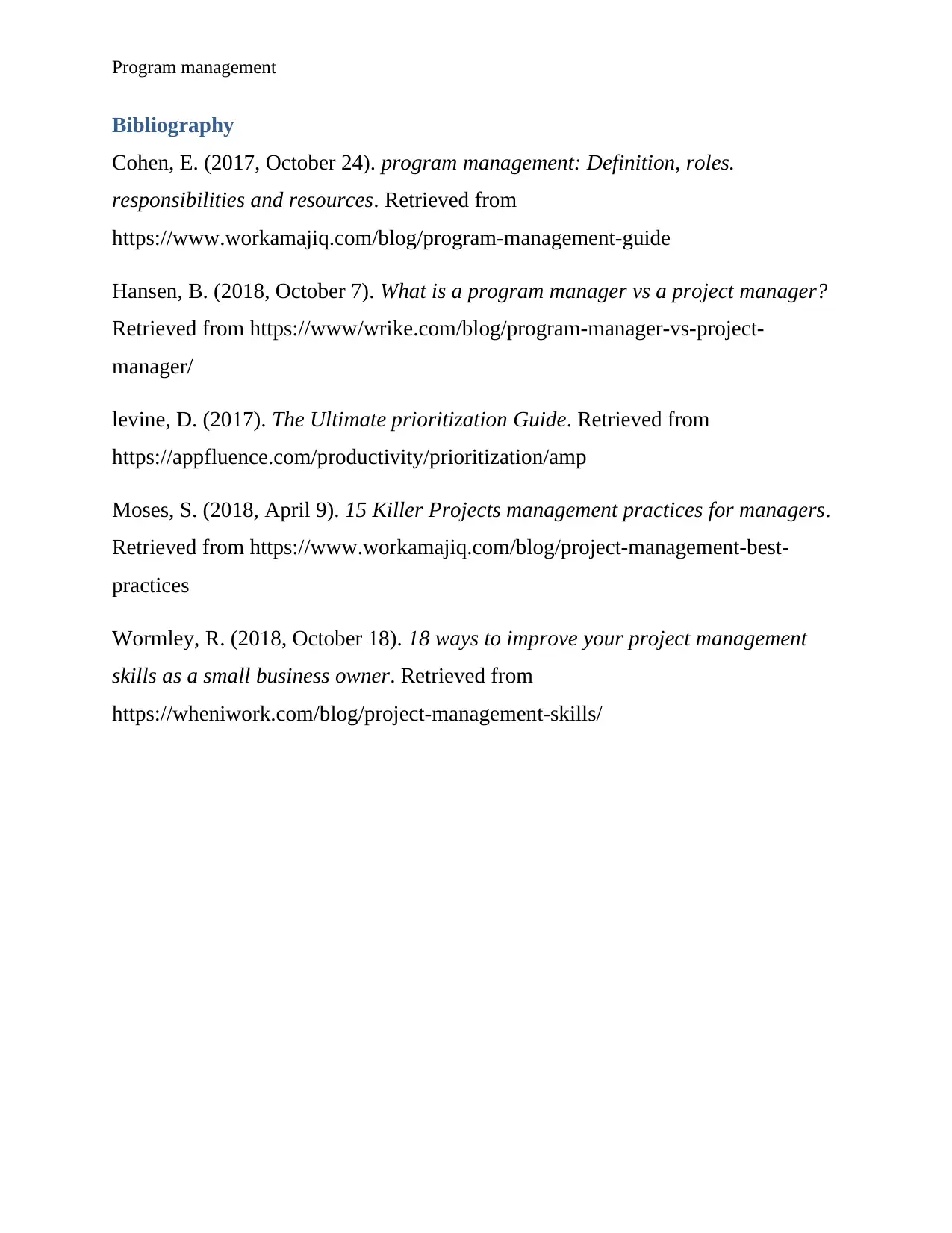
Program management
Bibliography
Cohen, E. (2017, October 24). program management: Definition, roles.
responsibilities and resources. Retrieved from
https://www.workamajiq.com/blog/program-management-guide
Hansen, B. (2018, October 7). What is a program manager vs a project manager?
Retrieved from https://www/wrike.com/blog/program-manager-vs-project-
manager/
levine, D. (2017). The Ultimate prioritization Guide. Retrieved from
https://appfluence.com/productivity/prioritization/amp
Moses, S. (2018, April 9). 15 Killer Projects management practices for managers.
Retrieved from https://www.workamajiq.com/blog/project-management-best-
practices
Wormley, R. (2018, October 18). 18 ways to improve your project management
skills as a small business owner. Retrieved from
https://wheniwork.com/blog/project-management-skills/
Bibliography
Cohen, E. (2017, October 24). program management: Definition, roles.
responsibilities and resources. Retrieved from
https://www.workamajiq.com/blog/program-management-guide
Hansen, B. (2018, October 7). What is a program manager vs a project manager?
Retrieved from https://www/wrike.com/blog/program-manager-vs-project-
manager/
levine, D. (2017). The Ultimate prioritization Guide. Retrieved from
https://appfluence.com/productivity/prioritization/amp
Moses, S. (2018, April 9). 15 Killer Projects management practices for managers.
Retrieved from https://www.workamajiq.com/blog/project-management-best-
practices
Wormley, R. (2018, October 18). 18 ways to improve your project management
skills as a small business owner. Retrieved from
https://wheniwork.com/blog/project-management-skills/
1 out of 8
Related Documents
Your All-in-One AI-Powered Toolkit for Academic Success.
+13062052269
info@desklib.com
Available 24*7 on WhatsApp / Email
![[object Object]](/_next/static/media/star-bottom.7253800d.svg)
Unlock your academic potential
Copyright © 2020–2025 A2Z Services. All Rights Reserved. Developed and managed by ZUCOL.





